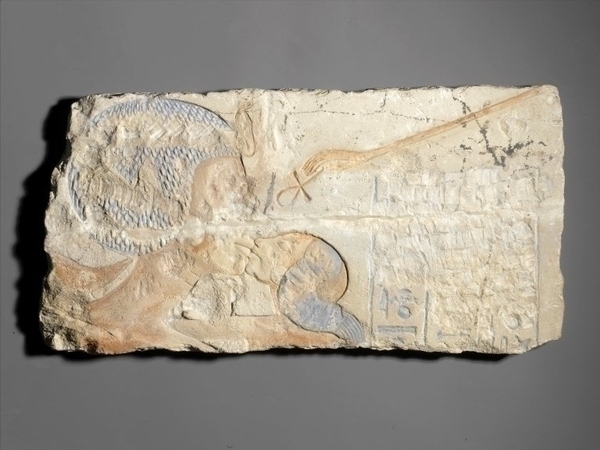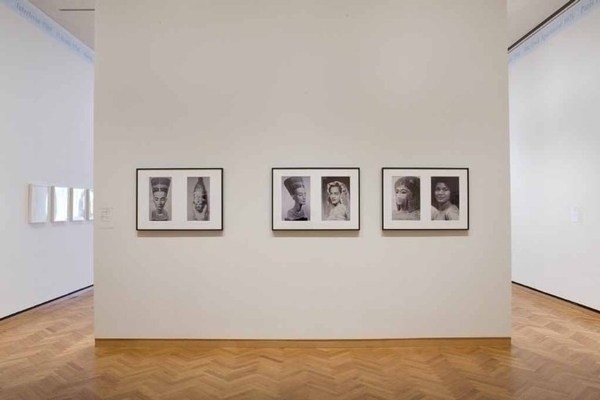Object of the Month: August 2010: Miscegenated Family Album
It’s when a work of art is able to communicate on many different levels at the same time – when it can speak to audiences on both an emotional and intellectual level – that I often feel it’s the most successful. That’s why I was thrilled when we were able to acquire Lorraine O’Grady’s Miscegenated Family Album last year.
Something remarkable happens when O’Grady combines her own family portraits with ancient Egyptian imagery. Some of these juxtapositions are tender and intimate, with mood and gestures strikingly fusing family and family matters millennia apart. The work immediately became a favorite of our installation Extended Family and it merges the personal with the historic, relating beyond the Contemporary Galleries to the Museum’s world renowned collection of Egyptian Art.
Lorraine O’Grady (American, born 1934). Miscegenated Family Album, 1994. Silver dye bleach (Cibachrome) print, 32 prints each: 20 x 16 in. (50.8 x 40.6 cm). Brooklyn Museum, Purchased with funds given by Shelley and Philip E. Aarons, John and Barbara Vogelstein, and bequest of Richard J. Kempe, by exchange, 2008.80. © Lorraine O’Grady
Miscegenated Family Album consists of sixteen pairs of black-and-white and color portraits. Each framed pair juxtaposes images of members of the artist’s family, often her sister Devonia, with images mostly portraying the Egyptian queen Nefertiti and her family. The work grew out of O’Grady’s 1980 performance, Nefertiti/Devonia Evangeline, which took place in front of a larger series of projected images of a similar kind. Devonia died unexpectedly at the age of thirty-seven before the sisters had time to reconcile their troubled relationship. The performance was a way for the artist to mourn her dead sister, her only sibling, and work through their fraught and complex bond.
The use of Egyptian imagery came naturally to O’Grady who found a physical resemblance between her sister and the Egyptian family imagery she chose. In the same way, she found similarities in the family histories. Nefertiti’s sister Mutnedjmet plays an important role in many of the pictures and the Egyptian queen disappeared from public life at an age close to Devonia’s at the time of her death. Egyptian art from this period around 1340 BC is known for its realistic and informal depictions of family life and its intimate portrayal of affection between family members. (The Brooklyn Museum has a wonderful collection of portrait reliefs from this period, including the piece called A Mother’s Kiss, which O’Grady used for her work—see below.)

Relief of Queen Nefertiti Kissing One of Her Daughters, ca. 1352-1336 B.C.E. Limestone, painted, 8 3/4 x 1 5/16 x 17 1/2 in. (22.2 x 3.4 x 44.5 cm). Brooklyn Museum, Charles Edwin Wilbour Fund, 60.197.8.
At the same time as the subject matter is deeply personal, through it O’Grady also addresses issues of class, racism, ethnography and African American art. The piece is also a commentary on hybridity. Born in Boston in 1934 to West Indian parents, O’Grady always approaches biculturalism in her art and acknowledges the importance of the diaspora experience for her life and work: the need to reconcile conflicting values and different backgrounds, and, as O’Grady writes, the necessity “to build a bridge to some other place.”
Miscegenated Family Album will remain on view until September 5.

Patrick Amsellem is the Associate Curator of Photography at the Brooklyn Museum. Formerly a curator at the Rooseum Center for Contemporary Art in Malmö, Sweden, Patrick organized the first Swedish exhibition of the work of Andreas Gursky and was part of the curatorial team that produced a major series of exhibitions under the leadership of Lars Nittve. He has written about art for Stockholm’s major newspaper Svenska Dagbladet and was also a critic for the Swedish daily newspaper Kvällposten and for Swedish Public Radio. Patrick has taught at New York University and is the author of several exhibition catalogues. He received a Ph.D. in Art History from New York University’s Institute of Fine Arts.

